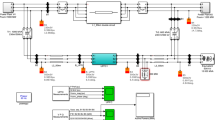Abstract
Protection against loss of excitation (LOE) in synchronous generators is requisite because of its harmful effects on both the generator and power system. This paper proposes a setting-free method to detect loss of excitation in synchronous generators. To this end, a flux-based method which is based on derivative of the flux is proposed in order to detect the fault. Because of negative amount of the flux derivative or rate of the flux variation at the LOE moment, it can be a good index to specify the fault. The proposed method does not require any threshold to act in different situation, for example, in different loads or existence of the FACTs devices. It should be stated that proposed relay will operate without any delay in all the mentioned situations. In order to validate the operation of the proposed method, some simulations have been done in MATLAB/Simulink software.

















Similar content being viewed by others
References
IEEE Guide for AC Generator Protection (2006) IEEE Standard. C37.102
Yulan Z, Yong X (1996) Operation statistics and analysis of relay protection and automatic devices of Chinese power systems in 1995. Power Syst Technol 20(12):57–61
Mozina CJ (2010) Lesson learned from generator tripping events. IEEE Ind Appl Mag 16(5):29–36
Lee C, Ma L, Weng C, Chen B (2011) Lessons learned from the generator loss of field at a cogeneration thermal power plant in Taiwan. IEEE Trans Power Syst 26(4):2093–2100
Mason CR (1949) A new loss-of-excitation relay for synchronous generators. Trans Am Inst Electr Eng 68(2):1240–1245
Tremaine RL, Blackburn JL (1954) Loss-of-field protection for synchronous machines. J Electr Eng 73(11):1008
Mason CR (1949) A new loss-of-excitation relay for synchronous genera-tors. Trans AIEE 68(2):1240–1245
Berdy J (1975) Loss-of-excitation protection for synchronous generators. IEEE Trans Power Appar Syst 94(5):1457–1463
Sharaf AM, Lie TT (1994) ANN based pattern classification of synchronous generator stability and loss of excitation. IEEE Trans Energy Convers 9(4):753–759
Morais AP, Cardoso G Mariotto (2010) An innovative loss-of-excitation protection based on the fuzzy inference mechanism. IEEE Trans Power Deliv 25(4):2197–2204
Samantaray SR, Dash PK (2008) Transmission line distance relaying using machine intelligence technique. IET Gener Transm Distrib 2(1):53–61
Chothani N, Bhalja B, Parikh U (2014) New support vector machine-based digital relaying scheme for discrimination between power swing and fault. IET Gener Transm Distrib 8(1):17–25
Bhalja B, Chothani N, Parikh U (2012) Development of a new bus zone identification algorithm using support vector machine. IET Gener Transm Distrib 6(7):710–718
Saini LM, Aggarwal SK, Kumar A (2010) Parameter optimization using genetic algorithm for support vector machine-based price-forecasting model in National electricity market. IET Gener Transm Distrib 4(1):36–49
Mladen Ostojic and Milenko Djuric (2017) The algorithm for the detection of loss of excitation of synchronous generators based on a digital-phase comparator. Springer (Electrical Engineering). https://doi.org/10.1007/s00202-017-0586-3
Ghorbani A, Soleymani S, Mozafari B (2015) A PMU-based LOE protection of synchronous generator in the presence of GIPFC. IEEE Trans Power Deliv. https://doi.org/10.1109/TPWRD.2015.2440314
Amraee T (2013) Loss-of-field detection in synchronous generators using decision tree technique. IET Gener Transm Distrib 7(9):943–954
Usta O, Musa MH, Bayrak M, Redfern MA (2007) A new relaying algorithm to detect loss of excitation of synchronous generators. Turk J Eletr Eng 15(3):339–349
Amini Mahdi, Davarpanah Mahdi, Sanaye-Pasand Majid (2015) A novel approach to detect the synchronous generator loss of excitation. IEEE Trans Power Deliv 30(3):1429–1438
Elsamahy M, Faried SO, Sidhu T (2014) Impact of midpoint STATCOM on generator loss of excitation protection mechanism. IEEE Trans Power Deliv 29(2):724–732
Working Group J-5 of the rotating machinery subcommittee, Power System Relay Committee (2009) Coordination of generator protection with excitation control and generator capability. In: 62nd Annual conference for protective relay engineers
Yaghobi Hamid (2015) Impact of static synchronous compensator on flux-based synchronous generator loss of excitation protection. IET Gener Transm Distrib 9(9):874–883
Yaghobi H, Mortazavi H (2015) A novel method to prevent incorrect operation of synchronous generator loss of excitation relay during and after different external faults. Int Trans Electr Energy Syst (ETEP) 25(9):1717–1735
Yaghobi H, Mortazavi H, Ansari K et al (2013) Study on application of flux linkage of synchronous generator for loss of excitation detection. Int Trans Electr Energy Syst (ETEP) 23(6):802–817
Yaghobi H, Mortazavi H, Ansari K, et al (2010) A novel flux-based method for synchronous generator loss of excitation protection. In 25th international power system conference, Iran, pp 1–14
Ong CM (1998) Dynamic simulation of electric machinery using MATLAB/SIMULINK, 2nd edn. Prentice Hal, New Jersey
Mahamedi Behnam, Zhu Jian Guo, Hashemi Sayyed Mohammad (2016) A setting-free approach to detecting loss of excitation in synchronous generators. IEEE Trans Power Deliv 31(5):2270–2278
Author information
Authors and Affiliations
Corresponding author
Additional information
Publisher’s Note
Springer Nature remains neutral with regard to jurisdictional claims in published maps and institutional affiliations.
Rights and permissions
About this article
Cite this article
Azari, M.N. A setting-free flux-based synchronous generator loss of excitation protection. Electr Eng 100, 2329–2339 (2018). https://doi.org/10.1007/s00202-018-0712-x
Received:
Accepted:
Published:
Issue Date:
DOI: https://doi.org/10.1007/s00202-018-0712-x




